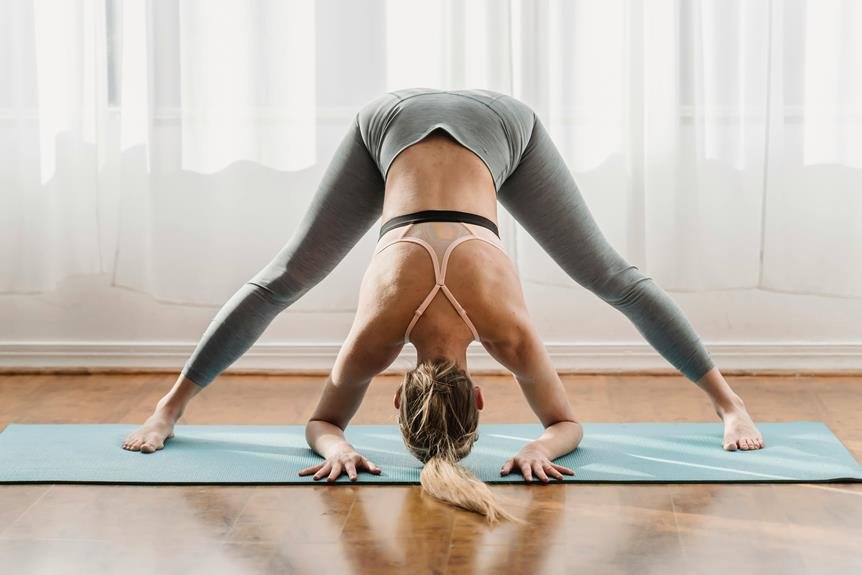Yoga Poses for Strengthening Your Back and Reducing Pain
As you navigate through your day, the demands placed on your back can sometimes lead to discomfort and pain. However, there are effective ways to counteract this strain and strengthen your back muscles to alleviate these issues.
By incorporating specific yoga poses into your routine, you can target key muscle groups, improve flexibility, and promote better posture. These poses not only offer relief but also contribute to a stronger, more resilient back.
Cat-Cow Pose
To strengthen your back muscles effectively, begin by practicing the Cat-Cow Pose in your yoga routine. This pose is a gentle yet powerful way to increase flexibility and strength in your spine. Start on your hands and knees, with your wrists directly under your shoulders and your knees under your hips.
As you inhale, arch your back and lift your head and tailbone towards the ceiling, creating the 'Cow' shape. Then, as you exhale, round your spine upwards like a cat, tucking your chin to your chest and pressing the floor away with your hands and knees. This movement helps to stretch and strengthen the muscles along your spine, improving your posture and reducing back pain.
The Cat-Cow Pose also helps to massage the organs in your abdomen, promoting digestion and releasing tension in your back. Practice this pose regularly, flowing smoothly between the two positions with each breath. Remember to focus on the alignment of your spine and engage your core muscles for optimal benefits.
Child's Pose
Begin your practice by easing into the comforting and restorative posture known as Child's Pose. This gentle pose is excellent for stretching out your lower back, hips, thighs, and ankles while promoting relaxation and stress relief. To get into Child's Pose, start on your hands and knees, then sit back on your heels as you extend your arms forward and lower your forehead to the mat. Take slow, deep breaths as you sink deeper into the pose, allowing your spine to lengthen and your muscles to relax.
Child's Pose is a fantastic way to release tension in your back and shoulders, making it a great posture for those with back pain or discomfort. It also helps to improve circulation and digestion while calming the mind. Stay in Child's Pose for several breaths, focusing on relaxation and letting go of any tension you may be holding onto. This pose can be a soothing way to start or end your yoga practice, providing a moment of peace and rejuvenation for your body and mind.
Downward-Facing Dog
Start by focusing on the alignment of your body in Downward-Facing Dog to ensure proper form.
This pose offers numerous benefits, including stretching and strengthening various muscles in your back.
Understanding the alignment and advantages of this pose can help improve your back strength and flexibility.
Alignment in Downward Dog
Achieve optimal alignment in Downward Dog by ensuring that your hands are shoulder-width apart and your feet are hip-width apart on the mat. This alignment helps distribute weight evenly and prevents strain on your wrists and shoulders.
Keep your fingers spread wide with the middle finger pointing forward to create a stable base. Engage your core by drawing your navel in towards your spine and lengthen your spine by reaching your hips up and back.
Relax your head and neck, allowing them to hang freely. Check that your heels are reaching towards the mat, but it's okay if they don't touch. Focus on creating a straight line from your wrists through your shoulders to your hips for a strong and effective Downward Dog pose.
Benefits of Pose
To experience the full range of benefits from the Downward-Facing Dog pose, maintain proper alignment and engage your core throughout the pose. This pose lengthens and stretches the spine, relieving tension and improving posture. Downward Dog also strengthens the back, shoulders, and arms while toning the core muscles.
By practicing this pose regularly, you can increase flexibility in the hamstrings and calves, promoting better overall body alignment. Downward Dog is known to calm the mind, reduce stress, and boost energy levels. It can also help improve circulation and digestion.
Remember to breathe deeply and consciously as you hold the pose, allowing the body to fully reap the rewards of this rejuvenating posture.
Cobra Pose
When practicing Cobra Pose, you'll discover its benefits for strengthening your back muscles.
Remember to maintain proper alignment by engaging your core and keeping your shoulders relaxed.
Beginners can explore modifications to gradually build strength and flexibility in this pose.
Benefits of Cobra Pose
Strengthening your back muscles and improving flexibility can be achieved through practicing the Cobra Pose in yoga.
This pose is beneficial in several ways. Cobra Pose helps to strengthen the spine, shoulders, and arms, which can alleviate back pain and improve posture.
By opening up the chest and stretching the front of the body, Cobra Pose can also help counteract the effects of sitting for long periods.
Additionally, practicing Cobra Pose regularly can increase the flexibility of the spine, improving overall mobility and reducing the risk of injuries.
This pose is a great way to target and strengthen the muscles that support the back, promoting a stronger and healthier spine.
Proper Alignment Tips
For proper alignment in Cobra Pose, focus on extending your arms and lifting your chest while keeping your shoulders relaxed. As you come into the pose, ensure that your hands are placed directly under your shoulders with your fingers pointing forward.
Press the tops of your feet and thighs into the mat while engaging your core muscles. Keep your elbows close to your body and gently squeeze your shoulder blades together to open up your chest. Remember to lengthen your neck by looking slightly upward, avoiding any strain on your neck muscles.
Modifications for Beginners
To make Cobra Pose more accessible for beginners, consider starting with a gentle variation that involves resting on your forearms instead of fully extending your arms. This modification helps reduce strain on your lower back and allows you to gradually build strength in your back muscles.
Begin by lying on your stomach with your palms facing down near your chest. As you inhale, slowly lift your head and chest off the ground, supporting yourself on your forearms. Keep your elbows close to your body and gently engage your back muscles. Hold the pose for a few breaths before releasing back down.
This modified Cobra Pose is a great way for beginners to experience the benefits of the pose while avoiding excessive strain.
Bridge Pose
Lift your hips off the ground, forming a straight line from your shoulders to your knees in Bridge Pose. This pose is excellent for strengthening the back muscles, especially the lower back. As you press your feet and arms into the mat, engage your core to support your spine. Bridge Pose also helps open up the chest and shoulders, promoting better posture.
To deepen the stretch and increase the challenge, you can interlace your fingers under your back and roll your shoulders underneath you. This variation enhances the backbend and provides a more intense stretch for the chest and shoulders. Remember to breathe deeply and relax into the pose, allowing your body to gradually open up and release tension.
Practicing Bridge Pose regularly can help alleviate back pain, improve spine flexibility, and enhance overall back strength. It's a versatile pose that can be adapted to different levels by adjusting the height of the bridge or exploring variations. Incorporate Bridge Pose into your yoga routine to experience its benefits for your back health.
Locust Pose
Engage your back muscles and extend your legs and arms off the ground in Locust Pose, creating a strong and active backbend. This pose targets various muscles in your back, helping to improve strength and flexibility. As you lift your legs and chest off the floor, focus on lengthening your spine and reaching through your fingertips. Keep your gaze forward to maintain alignment and prevent strain on your neck.
Locust Pose is beneficial for toning the muscles along your spine, including the erector spinae and trapezius muscles. It also engages your glutes and hamstrings, contributing to overall back stability. Practicing this pose regularly can help alleviate back pain and improve your posture.
To deepen the stretch in Locust Pose, you can experiment with lifting higher or holding the pose for longer periods. Remember to breathe deeply and mindfully throughout the practice to enhance relaxation and focus. Incorporate Locust Pose into your yoga routine to strengthen your back and reduce discomfort from prolonged sitting or standing.
Thread the Needle
Begin by positioning yourself on your hands and knees in a tabletop position for Thread the Needle pose. From here, inhale deeply as you raise your right arm up towards the ceiling, twisting your torso slightly. Exhale as you thread your right arm underneath your left arm, lowering your right shoulder and cheek to the mat. Keep your left hand grounded for support and gently press into it to deepen the stretch.
Feel the gentle twist in your spine and the opening in your shoulders. Breathe deeply into the pose, allowing your body to relax and release tension. Hold this position for a few breaths, focusing on deepening the stretch with each exhale.
Thread the Needle pose is excellent for stretching and releasing tension in the upper back, shoulders, and neck. It also helps improve spinal mobility and can alleviate discomfort caused by sitting for long periods. Remember to repeat the pose on both sides for balance and maximum benefit.
Sphinx Pose
Get into a comfortable lying position on your stomach to begin the Sphinx Pose. Place your forearms on the ground parallel to each other, elbows right under your shoulders. Press your hips and thighs into the mat while gently lifting your chest and head up. Keep your shoulders relaxed and away from your ears. Engage your core muscles to protect your lower back and lengthen your spine. Breathe deeply and hold the pose for about 30 seconds to 1 minute.
The Sphinx Pose is a gentle backbend that helps strengthen the spine, stretch the chest, lungs, and shoulders. It can also stimulate abdominal organs and relieve stress. Regular practice of this pose can improve posture and alleviate back pain. Remember not to overarch your back or put pressure on your lower back. Listen to your body and adjust the pose as needed to ensure comfort and safety.
Incorporate Sphinx Pose into your yoga routine to build back strength and flexibility while promoting relaxation and a sense of well-being.
Frequently Asked Questions
Can Yoga Poses Alone Completely Eliminate Back Pain, or Should They Be Used in Conjunction With Other Forms of Treatment or Therapy?
You can find relief with yoga poses for back pain, but they may not eliminate it entirely. Combining yoga with other treatments like physical therapy or medical care can provide a more comprehensive approach to healing.
Are There Any Specific Modifications or Variations of These Poses That Should Be Considered for Individuals With Existing Back Injuries or Conditions?
When dealing with existing back injuries or conditions, it's crucial to prioritize safety and comfort. Specific modifications or variations in yoga poses can help cater to your individual needs, ensuring a gentle and effective practice.
How Often Should These Yoga Poses Be Practiced in Order to See Noticeable Improvements in Back Strength and Reduction in Pain?
To see noticeable improvements in back strength and pain reduction, practice these yoga poses consistently. Aim for 3-5 times per week for optimal results. Listen to your body and adjust frequency based on how you feel.
Are There Any Specific Breathing Techniques That Should Be Incorporated While Performing These Poses to Enhance Their Benefits for the Back?
As you flow through poses, sync breath with movement. Inhale to elongate the spine, exhale to deepen the stretch. This mindful breathing enhances circulation, oxygenates muscles, and promotes relaxation, maximizing the benefits for your back.
Can These Yoga Poses Be Safely Practiced by Individuals of All Ages and Fitness Levels, or Are There Certain Precautions That Should Be Taken Before Attempting Them?
You can safely practice these yoga poses at any age or fitness level. However, it's important to listen to your body and modify the poses as needed. Consult a healthcare professional if you have any concerns.
Conclusion
So next time you're feeling the weight of the world on your shoulders, remember these yoga poses to strengthen your back and reduce pain.
Just like a tree needs strong roots to stand tall and weather any storm, your back needs these poses to support you through life's challenges.
Practice regularly and feel yourself growing stronger, standing taller, and moving with grace and ease.
Embrace the power of these poses and let your back become your strongest foundation.






